Canterbury Cathedral
by John P. Seely
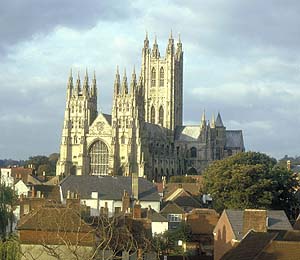 The history of Canterbury cathedral is the history
of Christianity in England. Since 597 AD Canterbury has been the
seat of the head of the Christian Church in England, the
archbishop of Canterbury. The present archbishop, the Most Revd
Dr Rowan Williams, is 104th in direct line of succession since
Augustus became the first archbishop of Canterbury and all
England and changed the course of English history. The history of Canterbury cathedral is the history
of Christianity in England. Since 597 AD Canterbury has been the
seat of the head of the Christian Church in England, the
archbishop of Canterbury. The present archbishop, the Most Revd
Dr Rowan Williams, is 104th in direct line of succession since
Augustus became the first archbishop of Canterbury and all
England and changed the course of English history.
Today, the Cathedral, the ruins of St Augustine's Abbey, and the
ancient Saint Martin's Church have been designated a UNESCO World
Heritage Site spanning 1500 years of English history.
Originally a Roman town called Durovernum, later Cantwarabyrig --
Old English meaning "fortress of the men of Kent" -- Canterbury
was already an important town, the Saxon capital of Kent, when St
Augustine first arrived on his mission to convert the pagan
English to Christianity.
"Not Angles, but Angels"
Augustine, a Roman Abbot, was sent at the head of a group of 40
monks by Pope Gregory the Great to bring the Bible to England in
what is one of the more romantic episodes in English history. The
primary source is the Venerable Bede's Ecclesiastical History
of the English People, which he completed in AD 731. Working
from his abbey at Jarrow, he wrote a detailed account of the
conversion of England utilizing a wide variety of sources from
all over England and Europe, including papal documents in
Rome.
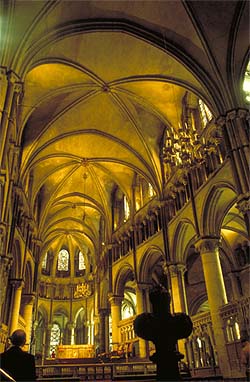 The
account begins in a Roman slave market, where the pope-to-be was
drawn to a group of fair-skinned, fine-haired youths on the
seller's block. When he was told that they were Angles (English)
he is supposed to have replied, in history's earliest recorded
pun, "Not Angles, but Angels -- for they have an angelic
face." and he went on to express great sadness that such divine-looking
people should still be unsaved. The story recounts how he started
to go himself to convert these unfortunates, but the pope ordered
him back. He never forgot these angels in human shape, so when he
himself was made pope, Gregory I -- now known as Gregory the
Great, he took the opportunity given by the marriage of the pagan
Kentish King, Æthelbert, to Bercta the daughter of the
Christian King of Paris, to send off his preachers. The
account begins in a Roman slave market, where the pope-to-be was
drawn to a group of fair-skinned, fine-haired youths on the
seller's block. When he was told that they were Angles (English)
he is supposed to have replied, in history's earliest recorded
pun, "Not Angles, but Angels -- for they have an angelic
face." and he went on to express great sadness that such divine-looking
people should still be unsaved. The story recounts how he started
to go himself to convert these unfortunates, but the pope ordered
him back. He never forgot these angels in human shape, so when he
himself was made pope, Gregory I -- now known as Gregory the
Great, he took the opportunity given by the marriage of the pagan
Kentish King, Æthelbert, to Bercta the daughter of the
Christian King of Paris, to send off his preachers.
Augustine and his monks landed at the Isle of Thanet, not far
from Canterbury, in 597. Æthelbert was initially a little
suspicious and confined them to the island while deciding what to
do about them. He eventually consented to an open-air audience,
being wary of inviting them into any dwelling in case they were
able to use magic arts to get the better of him. However, after
listening to what they had to say he is supposed to have
replied,
"Your words and promises are very fair, but as they are new to
us, and of uncertain import, I cannot approve of them so far as
to forsake that which I have so long followed with the whole
English nation. But because you are come from far into my
kingdom, and, as I conceive, are desirous to impart to us those
things which you believe to be true, and most beneficial, we will
not molest you, but give you favorable entertainment, and take
care to supply you with your necessary sustenance; nor do we
forbid you to preach and gain as many as you can to your
religion."
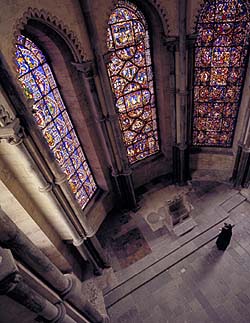 He gave Augustine
permission to stay in Canterbury, his capital. Bede describes
their procession as they arrive in Canterbury. He gave Augustine
permission to stay in Canterbury, his capital. Bede describes
their procession as they arrive in Canterbury.
"...as they drew near to the city, after their manner, with
the holy cross, and the image of our sovereign Lord and King,
Jesus Christ, they, in concert, sung this litany: "We beseech
Thee, O Lord, in all Thy mercy, that thy anger and wrath be
turned away from this city, and from the holy house, because we
have sinned. Hallelujah."
King Æthelbert was an early convert to the Christian
faith, and this greatly facilitated Augustine's work. The king
granted them land to build an abbey which was dedicated to SS
Peter and Paul. This was to be the final resting place for many
of Kent's kings and bishops. Augustine was later ordained as the
first archbishop of the English nation, which was rapidly turning
to Christianity. Augustine died in 604, and his remains were
moved into his abbey in AD612.
The arrival of Augustine signaled more than just the conversion
of the pagan English. It also opened England to a flood of
letters, arts and civilization from Europe. Latin was once again
heard and became the language of England's commerce, its worship
and its literature. England again became part of western
civilization. It is significant that shortly after the arrival of
Christianity, the laws of England first started to be written
down.
The Heritage Site
The Heritage Site at Canterbury consists of three areas:
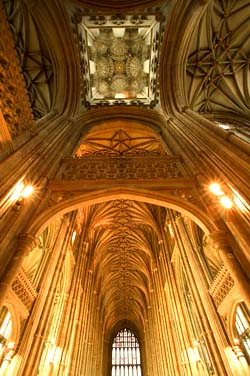 The
oldest is Saint Martin's church, a delightful little building and
England's oldest working parish church. It was being used by the
queen Bercta when Augustine and his monks first arrived and it
was here that they used to meet and pray. The church is freely
open to the public today and is a peaceful place to sit and
meditate on all that has taken place in this spot. The
oldest is Saint Martin's church, a delightful little building and
England's oldest working parish church. It was being used by the
queen Bercta when Augustine and his monks first arrived and it
was here that they used to meet and pray. The church is freely
open to the public today and is a peaceful place to sit and
meditate on all that has taken place in this spot.
A little to the west are remains of St Augustine's abbey. Towards
the end of the 10th century this was a Benedictine Abbey and
continued as one until it was ordered closed by Henry VIII at the
reformation. There is a small museum on the site today, which is
open daily. There is a small charge to enter the abbey ruins.
To the west of the abbey ruins, within the city walls, sits the
cathedral within its own walled precincts. This is a newer
cathedral, started in 1070. The site and extent of the original
Anglo-Saxon cathedral were only recently discovered to be on the
same site. Replacement of the flagstones in the nave, which were
becoming cracked and dangerous, revealed the walls of an earlier
building directly under the present cathedral These remains
themselves reveal four distinct phases of building, the earliest
being a simple church using Roman material. Bede tells us that
Augustine built his first church on the ruins of an older one,
though there is no evidence as to whether the material came from
a church or from other buildings.
This church was rebuilt and extended three times before being
destroyed completely by fire in 1067. The exact dates are of
course unknown. What is certain though, is that by the 11th
Century, the building was one of the largest and finest in
Northern Europe.
The last building phase is thought to have occurred in the 11th
century, possibly following the sacking and burning of Canterbury
in1011 by Danish raiders led by Thorkell the Tall and his
brother, Hemming. The then archbishop, Alphege, was taken for
ransom, but when he refused to pay, the drunken Danes threw ox
bones at him, finally killing him. Saint Alphege became
Canterbury's most popular martyr until supplanted by Thomas
Becket.
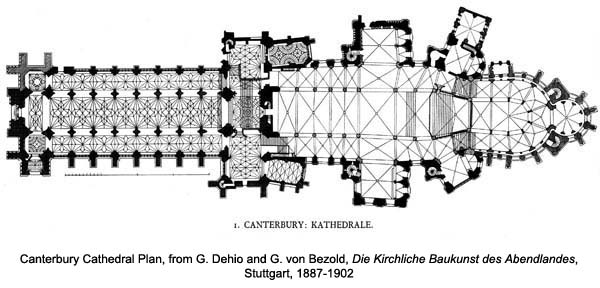
The "modern" church was designed and built by Bishop Lanfranc
between 1070 and 1077. It was built almost directly over the
remains of the Anglo-Saxon building but slightly to the south to
avoid the old walls. Major work has been carried out several
times since then, the latest between 1377 and 1405 when the nave
was demolished and rebuilt in the perpendicular style. The
cathedral as seen today was completed in 1498, but the quire,
eastern crypt, Trinity and Corona Chapels date back to between
1175 and 1184. The oldest section is the crypt, part of
Lanfranc's 11th century original. Some of the original wall
paintings and carved decorations remain.
"Who will rid me of this turbulent priest?"
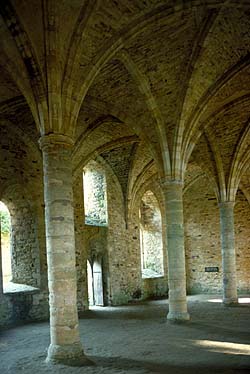 It was the martyrdom of
Thomas à Becket that made Canterbury England's most
important place of pilgrimage alongside Walsingham. Thomas
à Becket was a long time companion of the young king Henry
II, his friend and his chancellor. The king appointed him to the
position of archbishop of Canterbury, hoping to have a compliant
archbishop. Unfortunately for Henry's plans, the new post changed
Thomas Becket from a well-dressed man-about-the-town to an
austere churchman obsessed with maintaining the dignity and
independence of the church he now led. He continually thwarted
the king's plans to reform the clerical judicial system.
Relations between the king and the archbishop became worse and
worse and eventually Becket had to flee England. He spent nearly
seven years in exile before finally returning to England
following a reconciliation brokered by the pope. It was the martyrdom of
Thomas à Becket that made Canterbury England's most
important place of pilgrimage alongside Walsingham. Thomas
à Becket was a long time companion of the young king Henry
II, his friend and his chancellor. The king appointed him to the
position of archbishop of Canterbury, hoping to have a compliant
archbishop. Unfortunately for Henry's plans, the new post changed
Thomas Becket from a well-dressed man-about-the-town to an
austere churchman obsessed with maintaining the dignity and
independence of the church he now led. He continually thwarted
the king's plans to reform the clerical judicial system.
Relations between the king and the archbishop became worse and
worse and eventually Becket had to flee England. He spent nearly
seven years in exile before finally returning to England
following a reconciliation brokered by the pope.
This was a mistake because barely a month later, on Tuesday
December 29, 1170, four knights were spurred to action by the
King reputedly exclaiming,
"What a parcel of fools and dastards have I nourished in my
house that not one of them will avenge me of this one upstart
clerk!"
or as is more traditionally remembered,
"Who will rid me of this turbulent priest?"
Hoping to get the King's favor, the four knights rode to
Canterbury and murdered Thomas à Becket inside the
cathedral itself. The spot where this happened is today called
the Martyrdom and marked with a dramatic sculpture.
Within days the first miracles were reported and pilgrims began
arriving. Two years later Becket was canonized. Henry II himself
made a pilgrimage to the tomb in 1174 to ask for forgiveness for
any role he may have played in Becket's murder and allowed
himself to be scourged by the monks as penance. When the king of
Scotland was captured by Henry's troops on that very day,
everyone took it as a sign that Becket had forgiven the king.
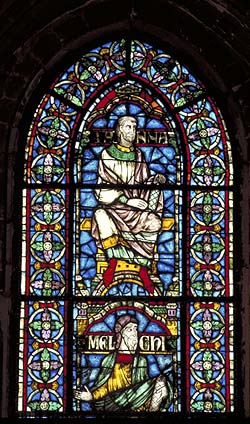 Canterbury soon became one of the great centers of
pilgrimage, rivaling even Rome and Jerusalem. Great prosperity
also came with the pilgrims. Canterbury grew to accommodate the
flood of visitors and the monks used the income to rebuild and
enlarge the cathedral. The center of Canterbury today is much how
medieval pilgrims would have seen it. It still has its cobbled
streets and narrow lanes of wooden framed buildings leaning out
over the roadway. Canterbury soon became one of the great centers of
pilgrimage, rivaling even Rome and Jerusalem. Great prosperity
also came with the pilgrims. Canterbury grew to accommodate the
flood of visitors and the monks used the income to rebuild and
enlarge the cathedral. The center of Canterbury today is much how
medieval pilgrims would have seen it. It still has its cobbled
streets and narrow lanes of wooden framed buildings leaning out
over the roadway.
Whanne that April with his shoures sote
The droughte of March hath perced to the rote.
Thanne longen folk to goon on pilgrimages
And specially from every shires ende Of Engelond,
to Caunterbury they wende,
The hooly blisful martir for to seke
That hem hath holpen, whan that they were seeke.
These famous lines are from the prologue to one of the greatest
books in English literature, The Canterbury Tales. Written
by Chaucer around 1387, describes a group of people making the
pilgrimage to the shrine of Saint Thomas à Becket, and the
stories they tell to help pass the time. Its characters are drawn
from a wide cross section of 14th century society: the prologue
in particular gives a picture of medieval life that is to be
found nowhere else. There is a Canterbury Tales Visitor
Attraction in town that will tell you more than probably want to
know about this book, its author, and its characters.
And if this isn't enough reason to visit, a tradition of selling
beer in the cathedral precincts has just been revived. A beer
made to a 300-year-old recipe by a brewery established in 1698 is
being sold in the cathedral precincts, all proceeds to the
cathedral fund. Beer was brewed in the abbey until the
reformation, and Thomas Becket himself would probably approve.
After all, he was once brewmaster at St Albans Abbey, and led a
brewer's delegation to France in 1158.
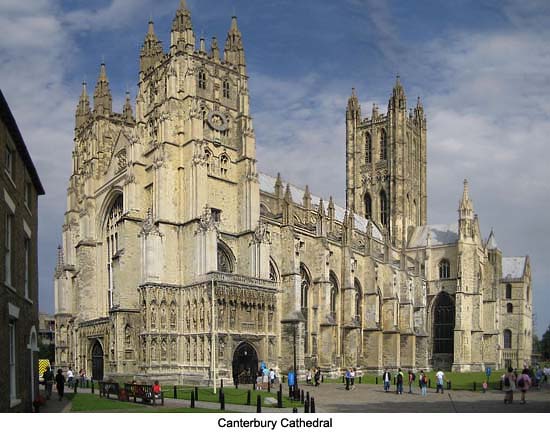
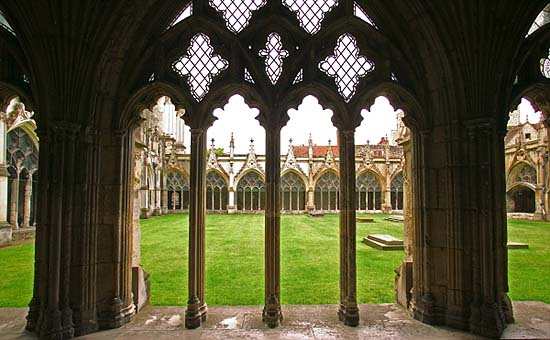
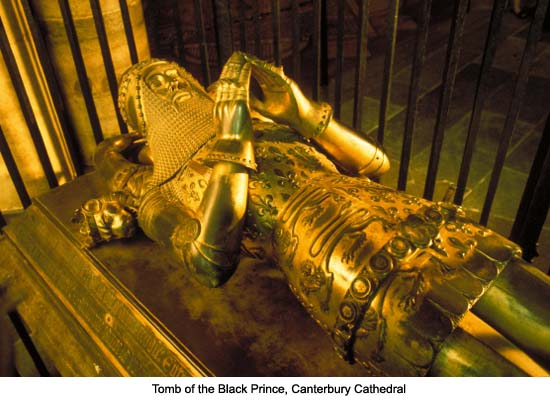
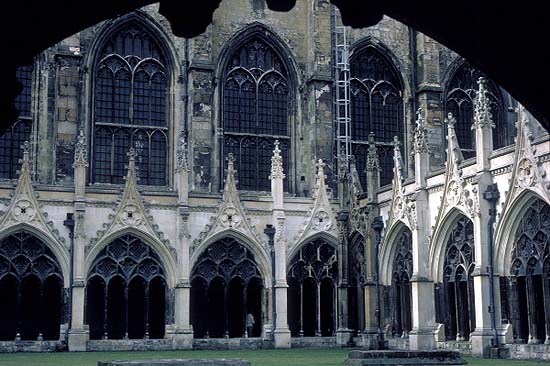
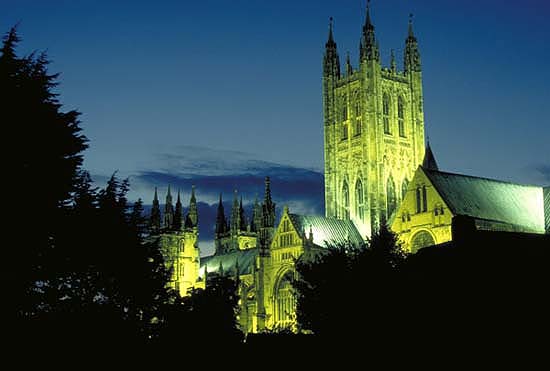
Related Articles:
- Canterbury: Still the Perfect Pilgrimage! by Julia Hickey
- https://www.timetravel-britain.com/articles/towns/canterbury.shtml
- Timeline: Canterbury, by Darcy Lewis
- https://www.timetravel-britain.com/articles/towns/cantime.shtml
- Read More about:
- The Hospital of St. Thomas
- St. Augustine's Abbey
- The History of the Archbishop of Canterbury
- The Canterbury Tales
- Thomas Becket
More Information:
We regret that we no longer have the resources to maintain up-to-date links and/or hours and pricing details for the various sites and attractions listed on this website. For more information about the location(s) listed above, please use your favorite search engine or visit Wikipedia.
John Seely is a freelance writer living in Thailand, who returns regularly to England. He writes regularly for local magazines and has also been published in International Living, Transitions Abroad
and Gonomad. Samples of his work can be found at http://www.johnpseely.com/Travelarticles.htm.
Article © 2006 John Seely
Photos courtesy of Canterbury Cathedral and Britainonview.com; cathedral exterior and plan courtesy of Wikipedia.org.
| 